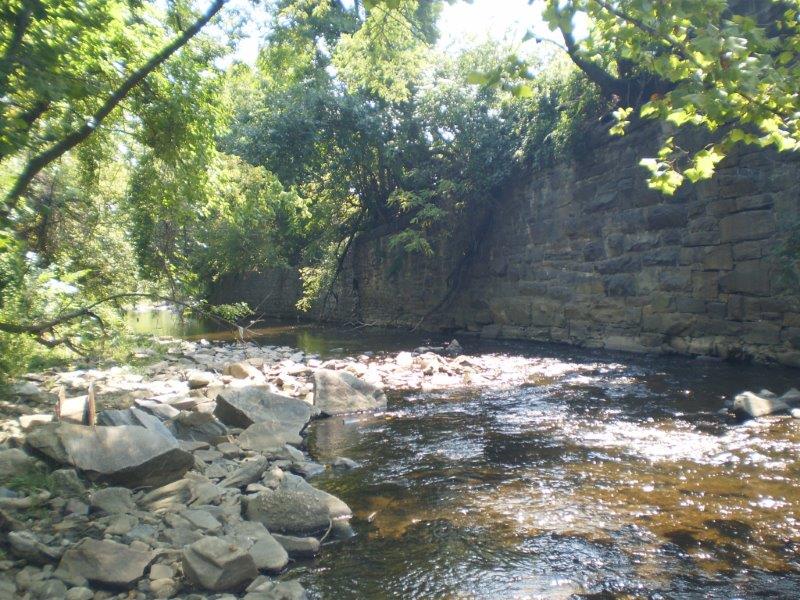The salt depot in an old roundhouse, just north of the Streetcar Museum off of Falls Road and across the street from the Jones Falls(Eric Schott)
Very large piles of salt as seen off of I- 895 (Eric Schott)
In my last blog post, I said that all of the ice and snow would be gone by now from the Jones Falls, and of course I was falling victim to wishful thinking! After a week of winter weather in March that can only be described as brutal, I thought, “What better topic to discuss in my blog other than road salt?” The lower Jones Falls has its own salt depot, shown in a photo above taken by fellow researcher Eric Schott (IMET/ UMCES). Also above is what some call “the salt range” or “the mother of all salt piles” off of I-895, also taken by Eric Schott. According to Wolf Pecher, much of this salt has been off- loaded from ships coming from South America (Chile and Brazil are the area’s biggest producers). There are mines for road salt located in upstate New York, but apparently much of the salt actually used in Maryland comes from 1000’s of miles away.
The salt depot shown above is located just to the east of Falls Road, just north of the Streetcar Museum and right across the street from the Jones Falls. If you visit the Streetcar Museum and go for a trolley ride (highly recommended!), your knowledgeable guide will tell you all you want to know about the building used for the salt depot. It turns out that this building was a roundhouse for the adjacent railroad line (Maryland and Pennsylvania). There would have been a turntable attached to the tracks in front of the building, which you would rotate to send the engines and cars into each one of the stalls that you see here. The B&O Railroad Museum downtown actually has one of these in good shape. Sadly, this historic building is in not so good shape, and part of the roof has begun to collapse. Word has it that they are moving the primary salt storage area to an area across the stream near the MTA building. I’m not sure what will become of the old roundhouse, but it would be a shame if it had to be demolished.
So the old saying goes, “there’s no such thing as a free lunch”. And so it is with road salt. There are obvious pros and cons to the use of this product on the roads. On the pro side, in a big way, is the fact that it can turn what would otherwise be a sheet of ice, impossible to drive on, to a wet road. Salt mixed with the precipitation creates a briny solution that has a much lower freezing point than regular water. If the temperature is between 25 and 32 F, you then get your wet road rather than icy skating rink. At temperatures lower than 25 F, the salt becomes less and less effective. In Maryland, using salt is quite useful as most of the snow we get is at the temperature between 25 and 32 F. Salt is a tremendous benefit to winter driving safety. I will admit that last Tuesday salt was the only thing that allowed me and my students to get home after class at 8 pm. Hence, it is unlikely that we will stop using road salt anytime soon.
I think a more relevant question at the moment is, “how much should be applied?” There are lots of reasons to limit road salt use to “just what we need”. Road salt eventually gets washed off of roads into storm drains, waterways, soil, lawns, ponds, gardens, etc. There are strong negative effects of this briny substance if it builds up over time. Plants are sensitive to salt, and in fact, the buildup of salt and other materials found in groundwater is one of the dangers of irrigating land in arid locations. Plants need special adaptations to live in salty water or soil. Most plants that we see away from the Bay just don’t have these adaptations. Salty water can seep into the groundwater and contaminate drinking water supplies (e.g. well water). And then there are the effects of salt on the rest of the ecosystem. Following rainstorms that wash away winter salt, relatively high levels of salt can easily be measured in streams receiving runoff. Because of saline runoff seeping into shallow groundwater, the actual peak in water salinity sometimes occurs as late as early summer. For fish, invertebrates, and algae that live in freshwater, the results can be devastating if the salt levels are too high. Organisms that are sensitive are probably long gone, and others have populations that have been reduced or under threat. This impact extends even to the microscopic world. Microbial communities can be changed in areas receiving road salt to halophilic, or ‘salt loving’ types of microbes such as Archaea or archaebacteria. This group of microbes often has adaptations for survival of extreme environments, such as heat, noxious chemicals, or in this case very high salt levels. The impact on microbial communities is just beginning to be understood, and is an active area of research. Wolf Pecher (UB) and Eric Schott (IMET- UMCES), PI and Co- PI on the EPA grant, are studying this issue in conjunction with Shiladitya DasSarma (IMET/ UMB). Changes at the most basic levels of the food web, such as bacteria, algae, and other microbes, signal a profound shift in ecosystem function which we do not yet understand. Currently, the state of Maryland is actively studying the question of how much salt should be applied to Maryland roads. Developing a standard would help prevent its overuse, and that would be a welcome development indeed.


